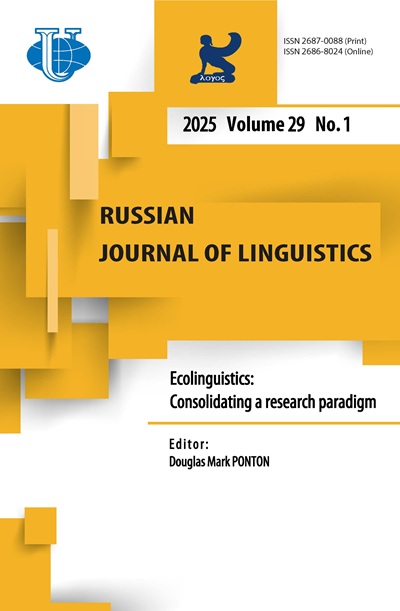На пути к новой лингвистической модели определения политической лжи
- Авторы: Эль-Завави А.М1
-
Учреждения:
- Университет Александрии
- Выпуск: Том 21, № 1 (2017): Дискурс-анализ в 21 веке: теория и практика (II)
- Страницы: 183-202
- Раздел: Статьи
- URL: https://journals.rudn.ru/linguistics/article/view/15411
- DOI: https://doi.org/10.22363/2312-9182-2017-21-1-183-202
Цитировать
Полный текст
Аннотация
Настоящее исследование рассматривает проблему того, каким образом предвыборная речь американских кандидатов в президенты, Дональда Трампа и Хиллари Клинтон, вводит в заблуждение избирателей. Были составлены два корпуса возможных лжевысказываний Клинтон и Трампа, каждый из которых содержал 16 утверждений, признанных сайтом Politifact (победитель Пулитцеровской премии) ложными или не соответствующими действительности. Некоторые заявления сопровождались видеозаписями, в то время как другие - нет, поскольку являлись либо твитами, либо событиями, которые не были выложены на YouTube или иной ресурс. В данном исследовании применялся метод контент-анализа в качестве трамплина для построения новой модели определения лжи в политическом дискурсе в соответствии с характеристиками дискурса кампании, что обеспечило качественный аспект исследования. Что касается количественных данных, то они были проанализированы с помощью программного обеспечения LIWC (Linguistic Inquiry and Word Count), а также ориентировались на анализ содержания обманных сигналов, которые могли быть сопоставлены с результатами, полученными из компьютеризированных данных. Для анализа стрессовых изменений голоса использовалась программа Praat. Для достижения высокой точности результатов в некоторых случаях нашел применение и статистический анализ. В исследовании делается вывод о том, что новая модель не является контекстно-зависимой, будучи количественной, и, таким образом, численно ориентированной в своих решениях. Вместе с тем, качественный анализ, особенно при изучении положений проекта Politifact, показывает, что контекст играет решающую роль в определении дискурса как вводящего или не вводящего в заблуждение.
Ключевые слова
Об авторах
Амр М Эль-Завави
Университет Александрии
Email: amrzuave@yahoo.com
El-Guish Road, El-Shatby, 21526 Александрия, Египет
Список литературы
- All False statements involving Hillary Clinton (Accessed on August 02, 2016). Retrieved from http://www.politifact.com/personalities/hillary-clinton/statements/byruling/false
- All False statements involving Hillary Clinton. (Accessed on August 03, 2016). Retrieved from http://www.politifact.com/personalities/donald-trump/statements
- Anolli, L., & Ciceri, R. (1997). The Voice of Deception: Vocal Strategies of Naive and Able Liars. Journal of Nonverbal Behavior, 21, 259-284
- Arciuli, J., Villar, G., & Mallard, D. (2009). Lies, Lies and More Lies. Proceedings of the 31st Annual Conference of the Cognitive Science Society (CogSci 2009), 2329-2334
- Vrij A. (2000) Detecting Lies and Deceit: The Psychology of Lying and the Implications for Professional Practice. New York: John Wiley & Sons
- Benus, S., Enos, F., Hirschberg, J., & Shriberg, E. (2006, May). Pauses in Deceptive Speech. Speech Prosody, vol. 18, 2-5
- DePaulo, B.M., Kashy, D.A., Kirkendol, S.E., Wyer, M.M. and Epstein J.A. (1996) Lying in Everyday Life. Journal of Personality and Social Psychology, vol. 70, 979-995
- DePaulo, B.M., Lindsay, J.J., Malone, B.E., Muhlenbruck, L., Charlton, K. and Cooper, H. (2003) Cues to Deception. Psychological Bulletin, Vol. 129, 74-118
- Bonikowski, B., & Gidron, N. (2015). The Populist Style in American Politics: Presidential Campaign Discourse, 1952-1996. Social Forces, sov. 120
- Burgoon, J.K., & Qin, T. (2006). The Dynamic Nature of Deceptive Verbal Communication. Journal of Language and Social Psychology, 25(1), 76-96
- Burgoon, J.K., Hamel, L., & Qin, T. Predicting Veracity from Linguistic Indicators. Intelligence and Security Informatics Conference (EISIC), 2012 European
- Connell, C. (2012) Linguistic Cues to Deception. MA thesis, Virginia Polytechnic Institute and State University. (Accessed on August 22, 2016). Retrieved from https://vtechworks.lib.vt.edu/ bitstream/handle/10919/32465/Connell_CA_T_2012rev.pdf?sequence=4&isAllowed=y
- Corn, D. (2004). The lies of George W. Bush: Mastering the politics of deception. Crown
- Demenko, G. (2008, May). Voice Stress Extraction. Speech Prosody, 6-9
- Donella, M. (1988) A Guide to American Campaign Language. (Accessed on July, 2016). Retrieved from: http://www.sustainabilityinstitute.org/dhm_archive/search.php?display_article= vn251languageed
- Ekman, P. (1991). Telling Lies: Clues to Deceit in the Marketplace, Politics, and Marriage. WW Norton & Company
- Emrich, C.G., Brower, H.H., Feldman, J.M., & Garland, H. (2001). Images in Words: Presidential Rhetoric, Charisma, and Greatness. Administrative Science Quarterly, 46(3), 527-557
- Fairclough, N. (2006) Tony Blair and the Language of Politics. UK: Routledge
- Frank, D.A., & McPhail, M.L. (2005). Barack Obama's Address to the 2004 Democratic National Convention: Trauma, Compromise, Consilience, and the (Im)possibility of Racial Reconciliation. Rhetoric & Public Affairs, 8(4), 571-593
- Kangas, S.E. (2014). What Can Software Tell us About Political Candidates?: A Critical Analysis of a Computerized Method for Political Discourse. Journal of Language and Politics, 13(1), 77-97
- Kirchhübel, C., & Howard, D.M. (2013). Detecting Suspicious Behaviour Using Speech: Acoustic Correlates of Deceptive Speech - An Exploratory Investigation. Applied Ergonomics, 44(5), 694-702
- Newman, M.L., Pennebaker, J.W., Berry, D.S., & Richards, J.M. (2003). Lying Words: Predicting Deception from Linguistic Styles. Personality and Social Psychology Bulletin, 29, 665-675
- Pennebaker, J.W., Boyd, R.L., Jordan, K., & Blackburn, K. (2015). The Development and Psychometric Properties of LIWC 2015. UT Faculty/Researcher Works
- Pernet, C.R., & Belin, P. (2012). The Role of Pitch and Timbre in Voice Gender Categorization. Frontiers in psychology, 3, 23
- Picornell, I. (2013). Analysing Deception in Written Witness Statements. Linguistic Evidence in Security, Law and Intelligence, 1(1), 41-50
- Raskin, D., & Esplin, P. (1991). Statement Validity Assessment: Interview Procedures and Content Analysis of Children’s Statements of Sexual Abuse. Behavioral Assessment, 13, 265-291
- Reynolds, E., & Rendle-Short, J. (2011). Cues to Deception in Context: Response Latency/Gaps in Denials and Blame Shifting. British Journal of Social Psychology, 50(3), 431-449
- Vrij, A., & Winkel, F.W. (1991). Cultural Patterns in Dutch and Surinam Nonverbal Behavior: An Analysis of Simulated Police/Citizen Encounters. Journal of Nonverbal behavior, 15(3), 169-184
- Wortham, S., Locher, M. (1999). Embedded Metapragmatics and Lying Politicians. Language & Communication, 19(2), 109-125
- Zhou, L., Burgoon, J.K., Twitchell, D.P., Qin, T.T., and Nunamaker, J.F., Jr. (2004) A Comparison of Classification Methods for Predicting Deception in Computer-Mediated Communication. Journal of Management Information Systems, 20, 4, 139-165
- Zuckerman, M., DePaulo, B.M., & Rosenthal, R. (1981). Verbal and Nonverbal Communication of Deception. In L. Berkowitz (Ed.). Advances in experimental social psychology.Vol. 14, 1-59. New York: Academic Press
- Praat: doing phonetics by computer. Downloaded from http://www.fon.hum.uva.nl/praat

















